
A | B | C | D | E | F | G | H | CH | I | J | K | L | M | N | O | P | Q | R | S | T | U | V | W | X | Y | Z | 0 | 1 | 2 | 3 | 4 | 5 | 6 | 7 | 8 | 9
Jamaica Jumieka (Jamaican Patois) | |
|---|---|
| Motto: "Out of Many, One People" | |
| Anthem: "Jamaica, Land We Love" | |
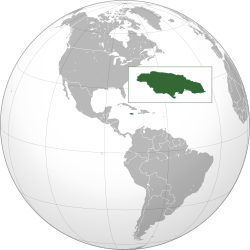 | |
| Capital and largest city | Kingston 17°58′17″N 76°47′35″W / 17.97139°N 76.79306°W |
| Official languages | English |
| National language | Jamaican Patois |
| Ethnic groups (2011[3]) |
|
| Religion |
|
| Demonym(s) | Jamaican |
| Government | Unitary parliamentary constitutional monarchy |
• Monarch | Charles III |
| Patrick Allen | |
| Andrew Holness | |
| Legislature | Parliament |
| Senate | |
| House of Representatives | |
| Independence from the United Kingdom | |
• Granted | 6 August 1962 |
| Area | |
• Total | 10,991 km2 (4,244 sq mi) (160th) |
• Water (%) | 1.5 |
| Population | |
• 2019 estimate | 2,734,092[5] (137th) |
• 2011 census | 2,697,983[6] |
• Density | 266[7]/km2 (688.9/sq mi) |
| GDP (PPP) | 2023 estimate |
• Total | |
• Per capita | |
| GDP (nominal) | 2023 estimate |
• Total | |
• Per capita | |
| Gini (2016) | medium |
| HDI (2022) | high (115th) |
| Currency | Jamaican dollar (JMD) |
| Time zone | UTC-5 |
| Driving side | left |
| Calling code | +1-876 +1-658 (Overlay of 876) |
| ISO 3166 code | JM |
| Internet TLD | .jm |
Jamaica (/dʒəˈmeɪkə/ jə-MAY-kə; Jamaican Patois: Jumieka [dʒʌˈmie̯ka]) is an island country in the Caribbean Sea and the West Indies. At 10,990 square kilometres (4,240 sq mi), it is the third largest island—after Cuba and Hispaniola—of the Greater Antilles and the Caribbean.[11] Jamaica lies about 145 km (90 mi) south of Cuba, 191 km (119 mi) west of Hispaniola (the island containing Haiti and the Dominican Republic), and 215 km (134 mi) south-east of the Cayman Islands (a British Overseas Territory).[11]
The indigenous Taíno peoples of the island gradually came under Spanish rule after the arrival of Christopher Columbus in 1494. Many of the indigenous people either were killed or died of diseases, after which the Spanish brought large numbers of Africans to Jamaica as slaves.[11] The island remained a possession of Spain, under the name Santiago, until 1655, when England (part of what would become the Kingdom of Great Britain) conquered it and named it Jamaica. It became an important part of the colonial British West Indies. Under Britain's colonial rule, Jamaica became a leading sugar exporter, with a plantation economy dependent on continued importation of African slaves and their descendants. The British fully emancipated all slaves in 1838, and many freedmen chose to have subsistence farms rather than to work on plantations. Beginning in the 1840s, the British began using Chinese and Indian indentured labourers for plantation work. Jamaicans achieved independence from the United Kingdom on 6 August 1962.[11]
With 2.8 million people,[12][13] Jamaica is the third most populous Anglophone country in the Americas (after the United States and Canada), and the fourth most populous country in the Caribbean. Kingston is the country's capital and largest city. Most Jamaicans are of Sub-Saharan African ancestry, with significant European, East Asian (primarily Chinese), Indian, Lebanese, and mixed-race minorities.[11] Because of a high rate of emigration for work since the 1960s, there is a large Jamaican diaspora, particularly in Canada, the United Kingdom, and the United States. The country has a global influence that belies its small size; it was the birthplace of the Rastafari religion, reggae music (and such associated genres as dub, ska and dancehall), and it is internationally prominent in sports, including cricket, sprinting, and athletics.[14][15][16][17] Jamaica has sometimes been considered the world's least populous cultural superpower.[18][19][20][21]
Jamaica is an upper-middle-income country[17] with an economy heavily dependent on tourism; it has an average of 4.3 million tourists a year.[22] The country performs favourably in measures of press freedom, democratic governance and sustainable well-being. Jamaica is a parliamentary constitutional monarchy with power vested in the bicameral Parliament of Jamaica, consisting of an appointed Senate and a directly elected House of Representatives.[11] Andrew Holness has served as Prime Minister of Jamaica since March 2016. As a Commonwealth realm, with Charles III as its king, the appointed representative of the Crown is the Governor-General of Jamaica, an office held by Patrick Allen since 2009.
Etymology
The indigenous people, the Taíno, called the island Xaymaca in their language,[a] meaning the "Land of Wood and Water" or the "Land of Springs".[23] Yamaye has been suggested as an early Taino name for the island as recorded by Christopher Columbus.[24]
Colloquially, Jamaicans refer to their home island as the "Rock". Slang names such as "Jamrock", "Jamdown" ("Jamdung" in Jamaican Patois), or briefly "Ja", have derived from this.[25][26]
History
Prehistory
There is no archaeological evidence of any human presence on Jamaica until about 500.[27] A group known as the "Redware people" after their pottery arrived circa 600,[28] followed by the Taíno circa 800, who most likely came from South America.[28][29] They practised an agrarian and fishing economy, and at their height are thought to have numbered some 60,000 people, grouped into around 200 villages headed by caciques (chiefs).[28] The south coast of Jamaica was the most populated, especially around the area now known as Old Harbour.[30]
Though often thought to have become extinct following contact with Europeans, the Taíno in fact still inhabited Jamaica when the English took control of the island in 1655.[30] Some fled into interior regions, merging with African Maroon communities.[31][32][33] The Jamaican National Heritage Trust is attempting to locate and document any remaining evidence of the Taíno.[34]
Spanish rule (1509–1655)

Christopher Columbus was the first European to see Jamaica, claiming the island for Spain after landing there in 1494 on his second voyage to the Americas.[28] His probable landing point was Dry Harbour, called Discovery Bay,[35] and St. Ann's Bay was named "Saint Gloria" by Columbus, as the first sighting of the land. He later returned in 1503; however, he was shipwrecked and he and his crew were forced to live on Jamaica for a year while waiting to be rescued.[36]
One and a half kilometres west of St. Ann's Bay is the site of the first Spanish settlement on the island, Sevilla, which was established in 1509 by Juan de Esquivel but abandoned around 1524 because it was deemed unhealthy.[37] The capital was moved to Spanish Town, then called St. Jago de la Vega, around 1534.[28][38] Meanwhile, the Taínos began dying in large numbers, both from introduced diseases and from enslavement by the Spanish.[28] As a result, the Spanish began importing slaves from Africa to the island.[39]
Many slaves managed to escape, forming autonomous communities in remote and easily defended areas in the interior of Jamaica, mixing with the remaining Taino; these communities became known as Maroons.[28] Many Jews fled the Spanish Inquisition to live on the island.[40] They lived as conversos and were often persecuted by the Spanish rulers, and some turned to piracy against the Spanish Empire's shipping.[41]
By the early 17th century it is estimated that no more than 2,500–3,000 people lived on Jamaica.[28][42][page needed]
Early British period
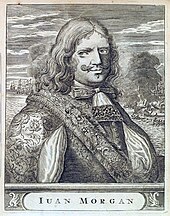
The English began taking an interest in the island and, following a failed attempt to conquer Santo Domingo on Hispaniola, Admiral William Penn and General Robert Venables led an invasion of Jamaica in 1655.[44] Battles at Ocho Rios in 1657 and the Rio Nuevo in 1658 resulted in Spanish defeats; in 1660 the Maroon community under the leadership of Juan de Bolas switched sides from the Spanish, and began supporting the English. With their help, the Spanish defeat was secured.[45] In 1661 English civil government was formed and Roundhead soldiers turned their attention to governance and agricultural responsibilities.[46]
When the English captured Jamaica, most Spanish colonists fled, with the exception of Spanish Jews, who chose to remain. Spanish slave holders freed their slaves before leaving.[45] Many slaves dispersed into the mountains, joining the already established maroon communities.[47] During the centuries of slavery, Jamaican Maroons established free communities in the mountainous interior of Jamaica, where they maintained their freedom and independence for generations, under the leadership of Maroon leaders such as Juan de Serras.[48]
Meanwhile, the Spanish made several attempts to re-capture the island, prompting the British to support pirates attacking Spanish ships in the Caribbean; as a result piracy became rampant on Jamaica, with the city of Port Royal becoming notorious for its lawlessness. Spain later recognised English possession of the island with the Treaty of Madrid (1670).[49] After that, the English authorities sought to rein in the worst excesses of the pirates.[28]
In 1660, the population of Jamaica was about 4,500 white and 1,500 black.[50] By the early 1670s, as the English developed sugar cane plantations worked by large numbers of slaves, black Africans formed a majority of the population.[51] The Irish in Jamaica also formed a large part of the island's early population, making up two-thirds of the white population on the island in the late 17th century, twice that of the English population. They were brought in as indentured labourers and soldiers after the conquest of 1655. The majority of Irish were transported by force as political prisoners of war from Ireland as a result of the ongoing Wars of the Three Kingdoms.[52] Migration of large numbers of Irish to the island continued into the 18th century.[53]
A limited form of local government was introduced with the creation of the House of Assembly of Jamaica in 1664; however, it represented only a tiny number of rich plantation owners.[54] In 1692, the colony was rocked by an earthquake that resulted in several thousand deaths and the almost complete destruction of Port Royal.[55]
18th–19th centuries

During the 1700s the economy boomed, based largely on sugar and other crops for export such as coffee, cotton and indigo. All these crops were worked by black slaves, who lived short and often brutal lives with no rights, being the property of a small planter-class.[28] In the 18th century, slaves ran away and joined the Maroons in increasing numbers, and resulted in The First Maroon War (1728 – 1739/40), which ended in stalemate. The British government sued for peace, and signed treaties with the Leeward Maroons led by Cudjoe and Accompong in 1739, and the Windward Maroons led by Quao and Queen Nanny in 1740.[56]
A large slave rebellion, known as Tacky's War, broke out in 1760 but was defeated by the British and their Maroon allies.[57] After the second conflict in 1795–96, many Maroons from the Maroon town of Cudjoe's Town (Trelawny Town) were expelled to Nova Scotia and, later, Sierra Leone.[28]
By the beginning of the 19th century, Jamaica's dependence on slave labour and a plantation economy had resulted in black people outnumbering white people by a ratio of almost 20 to 1. Although the British had outlawed the importation of slaves, some were still smuggled in from Spanish colonies and directly from Africa.[citation needed] While planning the abolition of slavery, the British Parliament passed laws to improve conditions for slaves. They banned the use of whips in the field and flogging of women; informed planters that slaves were to be allowed religious instruction, and required a free day during each week when slaves could sell their produce,[58] prohibiting Sunday markets to enable slaves to attend church.[citation needed] The House of Assembly in Jamaica resented and resisted the new laws. Members, with membership then restricted to European-descended Jamaicans, claimed that the slaves were content and objected to Parliament's interference in island affairs. Slave owners feared possible revolts if conditions were lightened.

The British abolished the slave trade in 1807, but not the institution itself.[59] In 1831 a huge slave rebellion, known as the Baptist War, broke out, led by the Baptist preacher Samuel Sharpe. The rebellion resulted in hundreds of deaths and the destruction of many plantations, and led to ferocious reprisals by the plantocracy class.[60] As a result of rebellions such as these, as well as the efforts of abolitionists, Britain outlawed slavery in its empire in 1834, with full emancipation from chattel slavery declared in 1838.[28] The population in 1834 was 371,070, of whom 15,000 were white, 5,000 free black; 40,000 "coloured" or free people of colour (mixed race); and 311,070 were slaves.[50] The resulting labour shortage prompted the British to begin to "import" indentured servants to supplement the labour pool, as many freedmen resisted working on the plantations.[28] Workers recruited from India began arriving in 1845, Chinese workers in 1854.[61] Many South Asian and Chinese descendants continue to reside in Jamaica today.[62][63]
Over the next 20 years, several epidemics of cholera, scarlet fever, and smallpox hit the island, killing almost 60,000 people (about 10 per day).[citation needed] Nevertheless, in 1871 the census recorded a population of 506,154 people, 246,573 of which were males, and 259,581 females. Their races were recorded as 13,101 white, 100,346 coloured (mixed black and white), and 392,707 black.[64] This period was marked by an economic slump, with many Jamaicans living in poverty. Dissatisfaction with this, and continued racial discrimination and marginalisation of the black majority, led to the outbreak of the Morant Bay rebellion in 1865 led by Paul Bogle, which was put down by Governor John Eyre with such brutality that he was recalled from his position.[28] His successor, John Peter Grant, enacted a series of social, financial and political reforms whilst aiming to uphold firm British rule over the island, which became a Crown Colony in 1866.[28] In 1872 the capital was transferred from Spanish Town to Kingston.[28]
Early 20th century

In 1907, Jamaica was struck by an earthquake which, together with the subsequent fire, resulted in considerable destruction in Kingston and caused the deaths of between 800 and 1,000 people.[65][28]
Unemployment and poverty remained a problem for many Jamaicans. Various movements seeking political change arose as a result, most notably the Universal Negro Improvement Association and African Communities League founded by Marcus Garvey in 1917. As well as seeking greater political rights and an improvement for the condition of workers, Garvey was also a prominent Pan-Africanist and proponent of the Back-to-Africa movement.[66] He was also one of the chief inspirations behind Rastafari, a religion founded in Jamaica in the 1930s that combined Christianity with an Afrocentric theology focused on the figure of Haile Selassie, Emperor of Ethiopia. Despite occasional persecution, Rastafari grew to become an established faith on the island, later spreading abroad.
The Great Depression of the 1930s hit Jamaica hard. As part of the British West Indian labour unrest of 1934–39, Jamaica saw numerous strikes, culminating in a strike in 1938 that turned into a riot.[67][28][68] As a result, the British government instituted a commission to look into the causes of the disturbances; their report recommended political and economic reforms in Britain's Caribbean colonies.[28][69] A new House of Representatives was established in 1944, elected by universal adult suffrage.[28] During this period Jamaica's two-party system emerged, with the creation of the Jamaican Labour Party (JLP) under Alexander Bustamante and the People's National Party (PNP) under Norman Manley.[28]
Jamaica slowly gained increasing autonomy from the United Kingdom. In 1958 it became a province in the Federation of the West Indies, a federation of several of Britain's Caribbean colonies.[28] Membership of the Federation proved to be divisive, however, and a referendum on the issue saw a slight majority voting to leave.[28] After leaving the Federation, Jamaica attained full independence on 6 August 1962.[28] The new state retained, however, its membership in the Commonwealth of Nations (with the British monarch as head of state) and adopted a Westminster-style parliamentary system. Bustamante, at the age of 78, became the country's first prime minister.[70][71]
Post-independence era
Strong economic growth, averaging approximately 6% per year, marked the first ten years of independence under conservative JLP governments; these were led by successive Prime Ministers Alexander Bustamante, Donald Sangster (who died of natural causes within two months of taking office) and Hugh Shearer.[28] The growth was fuelled by high levels of private investment in bauxite/alumina, tourism, the manufacturing industry and, to a lesser extent, the agricultural sector. In the 1967 Jamaican general election, the JLP were victorious again, winning 33 out of 53 seats, with the PNP taking 20 seats.[72]
In terms of foreign policy Jamaica became a member of the Non-Aligned Movement, seeking to retain strong ties with Britain and the United States whilst also developing links with Communist states such as Cuba.[28]
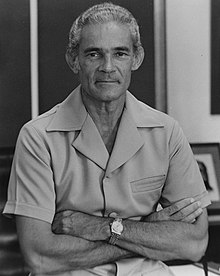
The optimism of the first decade was accompanied by a growing sense of inequality among many Afro-Jamaicans, and a concern that the benefits of growth were not being shared by the urban poor, many of whom ended up living in crime-ridden shanty towns in Kingston.[28] This led to the voters electing the PNP under Michael Manley in 1972. The PNP won 37 seats to the JLP's 16.[72]
Manley's government enacted various social reforms, such as a higher minimum wage, land reform, legislation for women's equality, greater housing construction and an increase in educational provision.[73][28] Internationally he improved ties with the Communist bloc and vigorously opposed the apartheid regime in South Africa.[28]
In 1976, the PNP won another landslide, winning 47 seats to the JLP's 13. The turnout was a very high 85 percent.[74] However, the economy faltered in this period due to a combination of internal and external factors (such as the oil shocks).[28] The rivalry between the JLP and PNP became intense, and political and gang-related violence grew significantly in this period.[28]
By 1980, Jamaica's gross national product had declined to some 25% below its 1972 level.[citation needed] Seeking change, Jamaicans voted the JLP back in in 1980 under Edward Seaga, the JLP winning 51 seats to the PNP's nine seats.[72][28] Firmly anti-Communist, Seaga cut ties with Cuba and sent troops to support the US invasion of Grenada in 1983.[28] The economic deterioration, however, continued into the mid-1980s, exacerbated by a number of factors. The largest and third-largest alumina producers, Alpart and Alcoa, closed; and there was a significant reduction in production by the second-largest producer, Alcan.[citation needed] Reynolds Jamaica Mines, Ltd. left the Jamaican industry. There was also a decline in tourism, which was important to the economy.[citation needed] Owing to rising foreign and local debt, accompanied by large fiscal deficits, the government sought International Monetary Fund (IMF) financing, which was dependent on implementing various austerity measures.[28] These resulted in strikes in 1985 and a decline in support for the Seaga government, exacerbated by criticism of the government's response to the devastation caused by Hurricane Gilbert in 1988.[28][75] Having now de-emphasised socialism and adopting a more centrist position, Michael Manley and the PNP were re-elected in 1989, winning 45 seats to the JLP's 15.[76][28]
The PNP went on to win a string of elections, under Prime Ministers Michael Manley (1989–1992), P. J. Patterson (1992–2005) and Portia Simpson-Miller (2005–2007). In the 1993 Jamaican general election, Patterson led the PNP to victory, winning 52 seats to the JLP's eight seats. Patterson also won the 1997 Jamaican general election, by another landslide margin of 50 seats to the JLP's 10 seats.[74] Patterson's third consecutive victory came in the 2002 Jamaican general election, when the PNP retained power, but with a reduced seat majority of 34 seats to 26. Patterson stepped down on 26 February 2006, and was replaced by Portia Simpson-Miller, Jamaica's first female Prime Minister. The turnout slowly declined during this period of time, from 67.4% in 1993 to 59.1% in 2002.[76]
During this period various economic reforms were introduced, such as deregulating the finance sector and floating the Jamaican dollar, as well as greater investment in infrastructure, whilst also retaining a strong social safety net.[28] Political violence, so prevalent in the previous two decades, declined significantly.[28][77]
In 2007 the PNP was defeated by the JLP by a narrow margin of 32 seats to 28, with a turnout of 61.46%.[78] This election ended 18 years of PNP rule, and Bruce Golding became the new prime minister.[79] Golding's tenure (2007–2010) was dominated by the effects of the global recession, as well as the fallout from an attempt by Jamaican police and military to arrest drug lord Christopher Coke in 2010 which erupted in violence, resulting in over 70 deaths.[28][80] As a result of this incident Golding resigned and was replaced by Andrew Holness in 2011.
Independence, however widely celebrated in Jamaica, has been questioned in the early 21st century. In 2011, a survey showed that approximately 60% of Jamaicans believe that the country would have been better off had it remained a British colony, with only 17% believing it would have been worse off, citing as problems years of social and fiscal mismanagement in the country.[81][82] Holness and the JLP were defeated in the 2011 Jamaican general election, which saw Portia Simpson-Miller and the PNP return to power. The number of seats had been increased to 63, and the PNP swept to power with a landslide 42 seats to the JLP's 21. The voter turnout was 53.17%.[83]
Holness's JLP won the 2016 general election narrowly, defeating Simpson-Miller's PNP, on 25 February. The PNP won 31 seats to the JLP's 32. As a result, Simpson-Miller became Opposition Leader for a second time. The voter turnout dipped below 50% for the first time, registering just 48.37%.[84]
In the 2020 general election, Andrew Holness made history for the JLP by accomplishing a second consecutive win for the Jamaica Labour Party, winning 49 seats to 14 won by the PNP, led this time by Peter Phillips. The last time a consecutive win occurred for the JLP was in 1980. However, the turnout at this election was just 37%, probably affected by the coronavirus pandemic.[85]
Government and politics
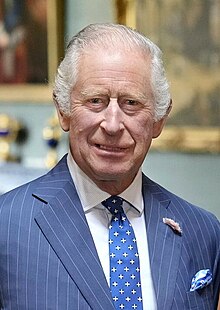
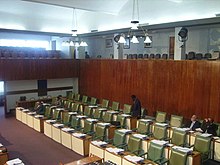
Jamaica is a parliamentary democracy and constitutional monarchy.[11][86] The head of state is the King of Jamaica (currently King Charles III),[87] represented locally by the Governor-General of Jamaica.[88][11][86] The governor-general is nominated by the Prime Minister of Jamaica and the entire Cabinet and then formally appointed by the monarch. All the members of the Cabinet are appointed by the governor-general on the advice of the prime minister. The monarch and the governor-general serve largely ceremonial roles, apart from their reserve powers for use in certain constitutional crisis situations. The position of the monarch has been a matter of continuing debate in Jamaica for many years; currently both major political parties are committed to transitioning to a republic with a president.[89][90]
Jamaica's current constitution was drafted in 1962 by a bipartisan joint committee of the Jamaican legislature. It came into force with the Jamaica Independence Act, 1962, which was passed by the Parliament of the United Kingdom, which gave Jamaica independence.[86]
The Parliament of Jamaica is bicameral, consisting of the House of Representatives (Lower House) and the Senate (Upper House). Members of the House (known as Members of Parliament or MPs) are directly elected, and the member of the House of Representatives who, in the governor-general's best judgement, is best able to command the confidence of a majority of the members of that House, is appointed by the governor-general to be the prime minister. Senators are nominated jointly by the prime minister and the parliamentary Leader of the Opposition and are then appointed by the governor-general.[86]
The Judiciary of Jamaica operates on a common law system derived from English law and Commonwealth of Nations precedents.[86] The court of final appeal is the Judicial Committee of the Privy Council, though during the 2000s Parliament attempted to replace it with the Caribbean Court of Justice.[citation needed]
Political parties and elections
Jamaica has traditionally had a two-party system, with power often alternating between the People's National Party (PNP) and Jamaica Labour Party (JLP).[86] The party with current administrative and legislative power is the Jamaica Labour Party, after its 2020 victory. There are also several minor parties who have yet to gain a seat in parliament; the largest of these is the National Democratic Movement (NDM).
Military

The Jamaica Defence Force (JDF) is the small but professional military force of Jamaica.[11] The JDF is based on the British military model with similar organisation, training, weapons and traditions. Once chosen, officer candidates are sent to one of several British or Canadian basic officer courses depending on the arm of service. Enlisted soldiers are given basic training at Up Park Camp or JDF Training Depot, Newcastle, both in St. Andrew. As with the British model, NCOs are given several levels of professional training as they rise up the ranks. Additional military schools are available for speciality training in Canada, the United States and the United Kingdom.[citation needed]
The JDF is directly descended from the British Army's West India Regiment, which was formed during the colonial era.[91] The West India Regiment was used extensively throughout the British Empire in policing the empire from 1795 to 1926. Other units in the JDF heritage include the early colonial Jamaica Militia, the Kingston Infantry Volunteers of WWI and reorganised into the Jamaican Infantry Volunteers in World War II. The West Indies Regiment was reformed in 1958 as part of the West Indies Federation, after dissolution of the Federation the JDF was established.[92]
The Jamaica Defence Force (JDF) comprises an infantry Regiment and Reserve Corps, an Air Wing, a Coast Guard fleet and a supporting Engineering Unit.[93] The infantry regiment contains the 1st, 2nd and 3rd (National Reserve) battalions. The JDF Air Wing is divided into three flight units, a training unit, a support unit and the JDF Air Wing (National Reserve). The Coast Guard is divided between seagoing crews and support crews who conduct maritime safety and maritime law enforcement as well as defence-related operations.[94]
The role of the support battalion is to provide support to boost numbers in combat and issue competency training in order to allow for the readiness of the force.[95] The 1st Engineer Regiment was formed due to an increased demand for military engineers and their role is to provide engineering services whenever and wherever they are needed.[96] The Headquarters JDF contains the JDF Commander, Command Staff as well as Intelligence, Judge Advocate office, Administrative and Procurement sections.[97]
In recent years the JDF has been called on to assist the nation's police, the Jamaica Constabulary Force (JCF), in fighting drug smuggling and a rising crime rate which includes one of the highest murder rates in the world. JDF units actively conduct armed patrols with the JCF in high-crime areas and known gang neighbourhoods. There has been vocal controversy as well as support of this JDF role. In early 2005, an Opposition leader, Edward Seaga, called for the merger of the JDF and JCF. This has not garnered support in either organisation nor among the majority of citizens.[citation needed] In 2017, Jamaica signed the UN treaty on the Prohibition of Nuclear Weapons.[98]
Administrative divisions
Jamaica is divided into 14 parishes, which are grouped into three historic counties that have no administrative relevance.[86]
In the context of local government the parishes are designated "Local Authorities". These local authorities are further styled as "Municipal Corporations", which are either city municipalities or town municipalities.[99] Any new city municipality must have a population of at least 50,000, and a town municipality a number set by the Minister of Local Government.[99] There are currently no town municipalities.
The local governments of the parishes of Kingston and St. Andrews are consolidated as the city municipality of Kingston & St. Andrew Municipal Corporation. The newest city municipality is the Municipality of Portmore, created 2003. While it is geographically located within the parish of St. Catherine, it is governed independently.
| Cornwall County | Capital | km2 | Middlesex County | Capital | km2 | Surrey County | Capital | km2 | |||
| 1 | Hanover | Lucea | 450 | 6 | Clarendon | May Pen | 1,196 | 11 | Kingston | Kingston | 25 |
| 2 | Saint Elizabeth | Black River | 1,212 | 7 | Manchester | Mandeville | 830 | 12 | Portland | Port Antonio | 814 |
| 3 | Saint James | Montego Bay | 595 | 8 | Saint Ann | St. Ann's Bay | 1,213 | 13 | Saint Andrew | Half Way Tree | 453 |
| 4 | Trelawny | Falmouth | 875 | 9 | Saint Catherine | Spanish Town | 1,192 | 14 | Saint Thomas | Morant Bay | 743 |
| 5 | Westmoreland | Savanna-la-Mar | 807 | 10 | Saint Mary | Port Maria | 611 | ||||
Text je dostupný za podmienok Creative Commons Attribution/Share-Alike License 3.0 Unported; prípadne za ďalších podmienok. Podrobnejšie informácie nájdete na stránke Podmienky použitia.
Antropológia
Aplikované vedy
Bibliometria
Dejiny vedy
Encyklopédie
Filozofia vedy
Forenzné vedy
Humanitné vedy
Knižničná veda
Kryogenika
Kryptológia
Kulturológia
Literárna veda
Medzidisciplinárne oblasti
Metódy kvantitatívnej analýzy
Metavedy
Metodika
Text je dostupný za podmienok Creative
Commons Attribution/Share-Alike License 3.0 Unported; prípadne za ďalších
podmienok.
Podrobnejšie informácie nájdete na stránke Podmienky
použitia.
www.astronomia.sk | www.biologia.sk | www.botanika.sk | www.dejiny.sk | www.economy.sk | www.elektrotechnika.sk | www.estetika.sk | www.farmakologia.sk | www.filozofia.sk | Fyzika | www.futurologia.sk | www.genetika.sk | www.chemia.sk | www.lingvistika.sk | www.politologia.sk | www.psychologia.sk | www.sexuologia.sk | www.sociologia.sk | www.veda.sk I www.zoologia.sk


